ChatGPT Guide in 2024: Definition, Top Use Cases & Limitations
OpenAI introduced ChatGPT on November 30, 2022. Since its initial release, the language model has stormed the internet (see Figure 1).
Although internet users across different sectors and backgrounds are excessively exploring ChatGPT, few of them understand the technology, mechanism and potential behind the tool. In this article, we will introduce ChatGPT in its various dimensions such as its:
- Training method
- Functioning method
- Use cases
- Limitations.
Figure 1. Metrics comparing the success of ChatGPT compared to other tech products
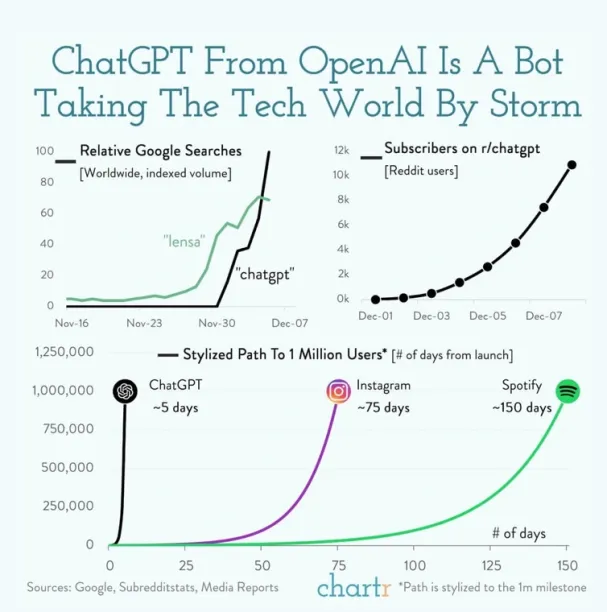
Source: Chartr
What is ChatGPT?
ChatGPT is a large language model (LLM) developed by OpenAI. It is based on the GPT-3 (Generative Pre-trained Transformer) architecture and is trained to generate human-like text. LLM is a machine learning model focused on natural language processing (NLP).
The model is pre-trained on a massive dataset of text, and then fine-tuned on specific tasks such as:
- Language translation
- Text summarization
- Code debugging
- Question answering, etc.
Because it is pre-trained, it can generate text that is more natural and fluent than models that are only fine-tuned on a specific task.
The language model has a high degree of accuracy, allowing it to look at conversations from one end to another and coming up with answers that appear human-like.1 This means it can understand and respond to natural language queries and follow them just as effectively as a human being can.
ChatGPT pricing
Well, considering its success, is ChatGPT free?
OpenAI states that during the research review, it is and will remain to be free.2 You can try it at chat.openai.com.
However, the co-founder of OpenAI, Greg Brockman declared in his twitter account that they are working on a paid and advanced version of ChatGPT for professionals.
How was ChatGPT trained?
GPT 3.5, a version of GPT-3 and the language model behind the ChatGPT, was trained on an Azure AI supercomputing infrastructure.
ChatGPT was modified and improved using both supervised and reinforcement learning methods, with the assistance of human trainers. The learning includes 3 steps (see Figure 2):
- Supervised learning: First, the model was given examples of conversations where humans played both the role of the user and the AI assistant.
- Reinforcement learning: Later, human trainers evaluated the responses generated by the model in previous conversations and used this feedback to create reward models.
- Proximal Policy Optimization (PPO): Lastly, the model was further fine-tuned on using a technique called PPO over multiple iterations.
Figure 2. The learning process of ChatGPT
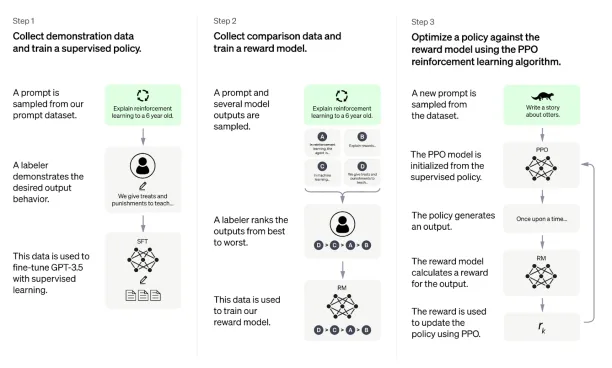
Source: OpenAI
Additionally, the language model GPT-3 has nearly 170 billion parameters and is trained on 570 GB of text, outpacing other LLMs (see Figure 3).3 Such large language models are possible thanks to AI chips’ ability for allowing higher and efficient computational skills.
Figure 3. Parameters used by different LLMs
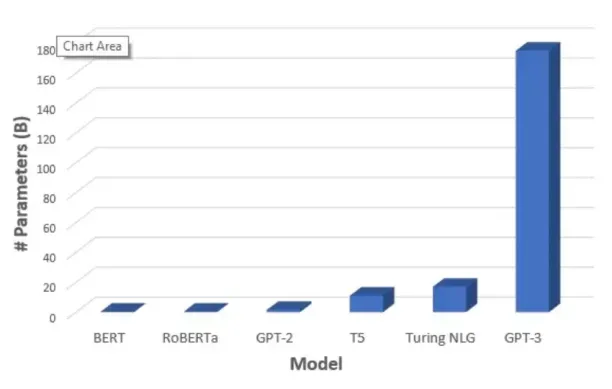
Source: Towards Data Science
How does ChatGPT work?
ChatGPT works by using a pre-trained transformer neural network architecture to generate text. The model is trained on a large dataset of text, called the common crawl dataset, which allows it to learn the patterns and structures of human-written text. It is created to predict the next word in a sentence given the previous words.
The model includes an encoder, which takes in the input text, and a decoder, which generates the output text:
- Encoder: Converts the input text into a fixed-length vector representation, which captures the meaning of the input text.
- Decoder: Uses this vector representation to generate the output text, one word at a time.
During the generation process, the model uses an attention mechanism, which allows it to weigh different parts of the input when making predictions. This helps it to generate more coherent and contextually appropriate text.
When the model is fine-tuned for a specific task, it is further trained on a smaller dataset that is specific to the task. For example, if the task is language translation, the model would be fine-tuned on a dataset of text in one language and their translations in another language. This fine-tuning process allows the model to learn task-specific patterns and structures, which improves its performance on the specific task.
It’s important to note, however, that the model’s ability to understand and respond to user input is limited by the data it was trained on and its ability to generalize from that data. If a user input is too different from the data the model has seen, it may not be able to generate a relevant or accurate response.
Top 6 use cases of ChatGPT
Chatbots and virtual assistants
ChatGPT is used to generate human-like responses in a conversational context, making it well-suited for building chatbots and virtual assistants for customer services. Having said that, ChatGPT is different to other chatbots. Explore their differences.
According to Forbes, several companies such as Meta, Canva, and Shopify, are already utilizing the technology that powers ChatGPT in their customer service chatbot systems.4
Language translation
ChatGPT can be fine-tuned on a specific task such as language translation, where it could be used to translate one language to another. The translation skill and speed of the model is impressive, as shown in the video below.
Text summarization
ChatGPT can provide text summarization, where it could be used to automatically summarize long documents or articles. In Figure 4, you can see an example of ChatGPT’s ability to summarize a section from the famous book Alice in Wonderland.
Figure 4. ChatGPT’s summary of an excerpt from the book Alice in Wonderland
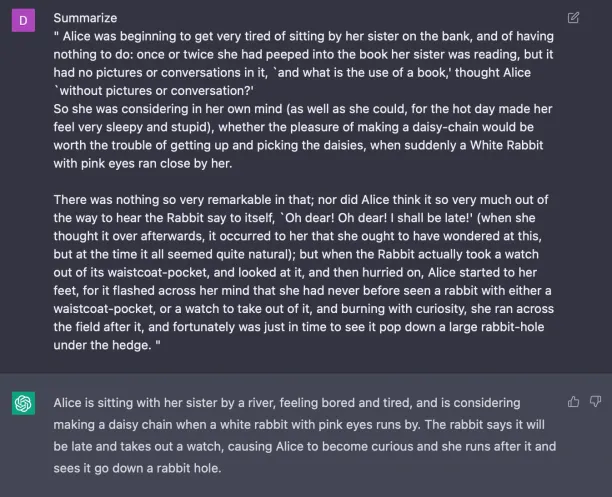
Source: ChatGPT by OpenAI
Content generation
ChatGPT can be used to generate new text based on patterns and relationships it has learned from the data it was trained on. This can be useful in applications such as:
- Content creation like new articles or blog posts
- Creative writing like stories or poems
- Recipe formation
- Homework preparation, etc.
Code debugging
ChatGPT can be used for code debugging in a few different ways:
- Generating code suggestions or fix code errors by providing context about the error and the desired outcome
- Giving natural language explanations for code, which can help developers understand how the code works and identify bugs
- Creating test cases, which can help to identify bugs that might not be immediately obvious
Search engine
Google has a strong and almost unbeatable advantage in the search engine market (see Figure 5). Despite being in a dominant position, Google is concerned. According to a recent interview from The New York Times, Google’s management team was reportedly on high alert due to the potential of ChatGPT to challenge its dominance and market share as a search engine.5
Figure 5. Worldwide desktop market share of leading search engines from January 2015 to December 2022
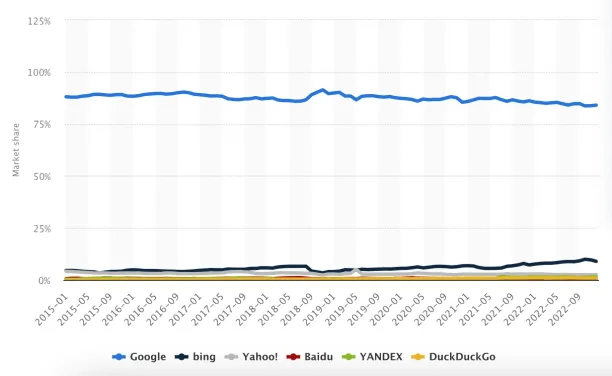
Source: Statista
As a search engine, one way is to use ChatGPT as a conversational search interface, where users can interact with the model through natural language input, and the model will respond with the most relevant information. The model can also improve its responses over time by learning from user interactions, making it more accurate and personalized as time goes on.
Limitations of ChatGPT
Biased responses and harmful instructions
ChatGPT is trained on a large dataset of text, which may contain biases as is the case with artificial intelligence biases. This can lead the model to generate biased responses, especially with regards to sensitive topics such as gender, race, and sexuality.
Despite taking steps to prevent the model from responding to inappropriate requests, it may still sometimes produce harmful responses. OpenAI states that they are utilizing the Moderation API to flag and prevent certain types of unsafe content. For this, they are leaning on human feedback to improve the model. To collect user feedback, it allows users to assess the responses.
However, despite modifications in the model to reject inappropriate requests, it is still possible to get the target answer from ChatGPT with simple tricks:
Outdated knowledge database
Since the model is trained on a specific dataset that only goes up until 2021, it is only able to provide information and respond to queries based on what it has learned from that dataset. If the dataset is out of date, the model’s responses may not be accurate or relevant to the current time.
Additionally, the model may not be able to understand or respond to new concepts, technologies or information that have emerged after the dataset was created.
Network and capacity error
ChatGPT network error is commonly encountered when the AI is generating long texts, where the chatbot takes more than 60 seconds to return an answer. Also, due to high demand, it occasionally turns out of capacity for some users (see Figure 6).
Figure 6. ChatGPT is at capacity error
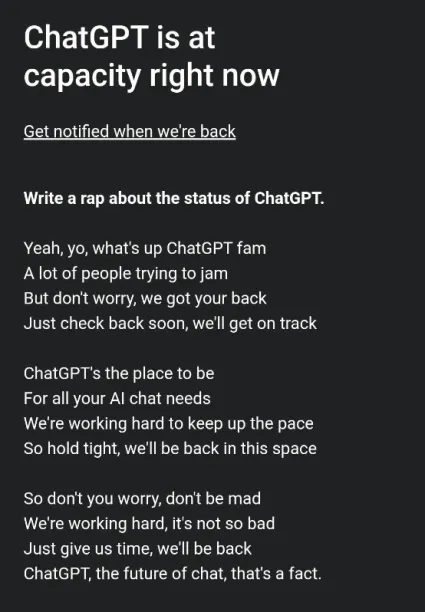
Source: ChatGPT by OpenAI
Overuse of certain phrases
The ChatGPT model is known to generate excessive and repetitive responses, including repeatedly stating that it is a language model trained by OpenAI. This is caused by bias in the training data, as declared by OpenAI.
Occasional incorrect answers
ChatGPT occasionally may generate reasonable-sounding yet incorrect or nonsensical answers. For example, to a user’s question about the UK government e-petitions, ChatGPT responds incorrectly (see Figure 7).
Figure 7. An example of ChatGPT providing an incorrect answer
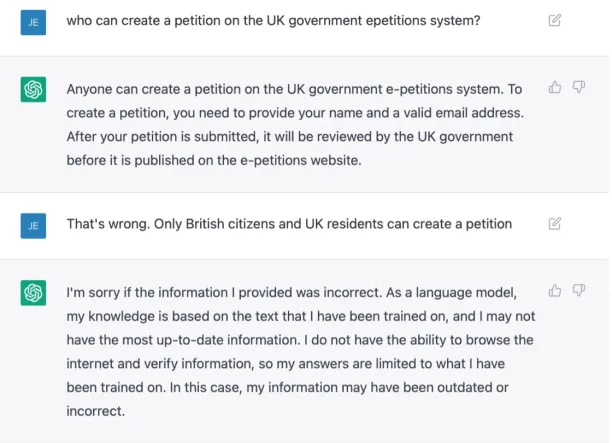
Source6: New Tech Observations from the UK, WordPress
ChatGPT does not access the internet to find answers. It builds a sentence word by word by choosing the most probable “token” that should follow based on its training. This means, ChatGPT generates responses by making a series of assumptions which might result in providing wrong answers, but with complete conviction.
Stack Overflow, a website frequently used by programmers and developers, has temporarily prohibited its users from sharing responses generated by ChatGPT due to this problem.7
OpenAI recognizes this limitation of ChatGPT to answer correctly and states that fixing this is not easy due to the training method of the chatbot.
If you have questions or need help regarding ChatGPT, feel free to reach out:
External Links
- 1. “What Is ChatGPT, the AI Chatbot That Everyone Is Talking About? – Tech News Briefing – WSJ Podcasts.” The Wall Street Journal, 7 December 2022, https://www.wsj.com/podcasts/tech-news-briefing/what-is-chatgpt-the-ai-chatbot-that-everyone-is-talking-about/52dc7d29-13cd-4be2-85ae-ac958004239f. Accessed 20 January 2023.
- 2. “ChatGPT: Optimizing Language Models for Dialogue.” OpenAI, 30 November 2022, https://openai.com/blog/chatgpt/. Accessed 20 January 2023.
- 3. “How Large Language Models Will Transform Science, Society, and AI.” Stanford HAI, 5 February 2021, https://hai.stanford.edu/news/how-large-language-models-will-transform-science-society-and-ai. Accessed 20 January 2023.
- 4. “ChatGPT Is Coming To A Customer Service Chatbot Near You.” Forbes, https://www.forbes.com/sites/rashishrivastava/2023/01/09/chatgpt-is-coming-to-a-customer-service-chatbot-near-you/?sh=1af3b08e7eca. Accessed 20 January 2023.
- 5. “ChatGPT and Other Chat Bots Are a ‘Code Red’ for Google Search.” The New York Times, 21 December 2022, https://www.nytimes.com/2022/12/21/technology/ai-chatgpt-google-search.html. Accessed 20 January 2023.
- 6. Fishenden, Jerry. “ChatGPT—inaccurate and derivative – new tech observations from the UK (ntouk).” new tech observations from the UK (ntouk), WordPress, 2022, https://ntouk.wordpress.com/2022/12/04/chatgpt-inaccurate-and-derivative/. Accessed 20 January 2023.
- 7. “Temporary policy: ChatGPT is banned.” Meta Stack Overflow, 5 December 2022, https://meta.stackoverflow.com/questions/421831/temporary-policy-chatgpt-is-banned. Accessed 20 January 2023.

Cem has been the principal analyst at AIMultiple since 2017. AIMultiple informs hundreds of thousands of businesses (as per similarWeb) including 60% of Fortune 500 every month.
Cem's work has been cited by leading global publications including Business Insider, Forbes, Washington Post, global firms like Deloitte, HPE, NGOs like World Economic Forum and supranational organizations like European Commission. You can see more reputable companies and media that referenced AIMultiple.
Throughout his career, Cem served as a tech consultant, tech buyer and tech entrepreneur. He advised businesses on their enterprise software, automation, cloud, AI / ML and other technology related decisions at McKinsey & Company and Altman Solon for more than a decade. He also published a McKinsey report on digitalization.
He led technology strategy and procurement of a telco while reporting to the CEO. He has also led commercial growth of deep tech company Hypatos that reached a 7 digit annual recurring revenue and a 9 digit valuation from 0 within 2 years. Cem's work in Hypatos was covered by leading technology publications like TechCrunch and Business Insider.
Cem regularly speaks at international technology conferences. He graduated from Bogazici University as a computer engineer and holds an MBA from Columbia Business School.
To stay up-to-date on B2B tech & accelerate your enterprise:
Follow on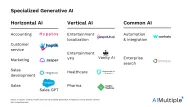
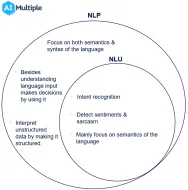
Comments
Your email address will not be published. All fields are required.